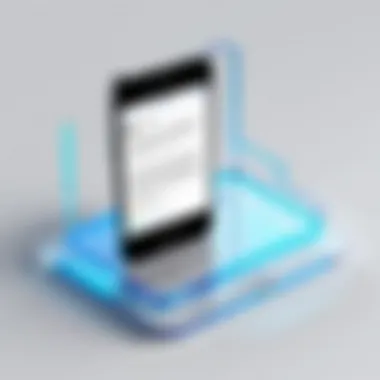Recovering Deleted iPhone Messages: Your Complete Guide


Intro
Smartphones have changed how we communicate, but the reality is that sometimes we lose important messages. Deleting messages, whether by accident or intention, can lead to frustration. Knowing how to recover deleted messages from an iPhone can ease that tension. The methods for recovery vary in their approaches, depending on whether you prefer built-in options or third-party applications. This guide aims to inform users about these various recovery pathways, emphasizing data privacy and success rates.
Overview of the Technology
Recovery of deleted messages on an iPhone may not rely on brand-new technology, but it hinges on understanding iOS features and backup systems. iCloud and iTunes are two foundational services that play crucial roles in data management.
- iCloud: A cloud storage platform, iCloud syncs data across devices and maintains backups on the internet. This means if messages are deleted, users may often restore them from recent backups.
- iTunes: This desktop application allows users to back up their devices locally on computers. It offers an additional method of retrieving lost data, especially for those who prefer keeping their data on steeper local systems rather than in the cloud.
To maximize the chance of successful recovery, it’s essential to understand both the specifications and limitations of these technologies.
Built-In Recovery Options
Using iCloud for Recovery
- Backup Restoration: If you have iCloud backups enabled, recovering deleted messages can be straightforward. Accessing a backup involves:
- Limitations: This method will restore the entire backup, and users may lose recently created data.
- Going to Settings > [Your Name] > iCloud > Manage Storage > Backups.
- Confirm the backup date prior to the deletion.
- Reset the iPhone by navigating to Settings > General > Reset.
- Select Erase All Content and Settings.
- Follow the setup prompts and restore the device from iCloud during setup.
Using iTunes for Recovery
- Backup Restoration: If the user prefers iTunes, they can:
- Limitations: Similar to iCloud, this method can overwrite newer data not included in the backup.
- Connect the iPhone to a computer.
- Open iTunes and select the device.
- Click on Restore Backup,
- Select the appropriate backup and confirm the restoration.
Third-Party Software Solutions
For those who are not comfortable using built-in methods or do not have backups, third-party software offers alternatives. Some recognizable software options include:
- Dr.Fone by Wondershare
- Tenorshare UltData
- EaseUS MobiSaver
These tools often feature user-friendly interfaces and promise to extract deleted messages without a backup. Their effectiveness can vary widely based on several factors, including the length of time since deletion and existing device data management practices. It’s essential to read reviews and choose a reputable product.
End
Recovering deleted messages from an iPhone requires an understanding of the technology involved and the methods available. Users should weigh the benefits and drawbacks of built-in options versus third-party solutions, considering their individual situations regarding backups and data security. Users must also realize that success is not guaranteed, and preventative measures like regular backups can save a lot of hassle.
Understanding Message Deletion on iPhone
The ability to recover deleted messages from an iPhone stems from understanding how the deletion process operates. This knowledge not only informs users about their options but also sheds light on the limitations inherent in recovery methods. When a message is deleted, differing mechanisms determine its recoverability based on the message type and how it is stored within the iPhone's architecture. This section addresses the significance of differentiating between SMS, MMS, and iMessages, as well as the implications of immediate versus permanent deletion. Knowing these distinctions is crucial, as they directly influence the feasibility of recovery efforts.
Types of Messages on iPhone
SMS and MMS
SMS (Short Message Service) and MMS (Multimedia Messaging Service) are staple features of mobile communication. SMS primarily facilitates the exchange of text-based messages, while MMS extends this functionality to include multimedia. The key characteristic of SMS and MMS is their universal presence across all mobile devices, not just iPhones. This universality makes them a popular choice for communication, ensuring that users can engage with both iPhone and non-iPhone users alike.
In terms of recovery, SMS and MMS rely on the device's storage system. When a user deletes a text or multimedia message, it is marked for deletion, though it may still reside in the device’s memory for a limited time. However, since these messages are not stored on Apple’s cloud services by default, recovering them demands meticulous attention to backup settings.


iMessages
iMessages, exclusive to Apple devices, present a different dynamic compared to SMS and MMS. They leverage the internet for message transmission, allowing users to send text, photos, videos, and other content seamlessly. The key characteristic of iMessages is their integration with Apple’s ecosystem, providing features like read receipts and end-to-end encryption. This connectivity and security make iMessages a beneficial choice for those embedded within Apple's world.
Upon deletion, iMessages may become irretrievable based on whether they were backed up to iCloud. The unique feature of iMessages lies in this backup capability. If a backup exists, restoration is feasible, yet failure to back up means a high likelihood of permanent loss.
What Happens When Messages Are Deleted?
Immediate Deletion vs. Permanent Deletion
Understanding the difference between immediate and permanent deletion is pivotal. When a message is marked as deleted, it goes through an immediate deletion phase, where it is removed from view but can still be recoverable if acted upon swiftly. Solution seekers often find this stage beneficial, as it allows for potential recovery through system restoration methods.
On the other hand, once the device overwrites the space where the deleted message was stored, that message enters a state of permanent deletion. In this context, recovery becomes highly challenging.
Effects on Storage
The effects on storage address how message deletion influences available memory. When a user deletes messages, storage space is often reclaimed immediately. However, until the system overwrites this data, remnants may linger in the system. Understanding this nuance assists users in exploring recovery options. It boils down to timing; acting quickly can increase the chances of successful restoration, while waiting can lead to missed opportunities.
[Note: Recovery success largely depends on how much time has passed since deletion and the preventive measures taken beforehand.]
Thus, comprehending the pathways of message deletion informs users about what can be done post-deletion and sets realistic expectations when seeking to retrieve lost communications.
Built-in Recovery Options
When it comes to recovering deleted messages from your iPhone, the built-in recovery options offered by Apple are invaluable. These methods cater to various scenarios, enhancing the likelihood of retrieving lost messages without relying on third-party tools. The primary benefits include accessibility, ease of use, and integration within existing Apple ecosystems. If users frequently back up their devices, the chances of successful recovery significantly increase.
Recovering Messages from iCloud Backup
Accessing iCloud Settings
Accessing iCloud settings is a fundamental step for users considering recovery through iCloud. This process allows you to verify if you have enabled backups for your messages, which is crucial for recovery. The key characteristic of iCloud settings is their simplicity; users can navigate to the settings app, tap on their name, and select iCloud. This step is popular due to its direct access to numerous features, including storage management and message backups. A unique feature here is the absence of additional software requirements, allowing seamless integration into everyday use. However, reliance on iCloud may pose disadvantages, as it requires a certain level of internet connectivity and adequate iCloud storage.
Restoring from iCloud Backup
Restoring from an iCloud backup is a powerful tool for recovering messages deleted from the iPhone. This method allows users to revert their devices to a previous state, retrieving messages that may have been lost. The key characteristic of this restoration process is its candidate for a widespread choice among iPhone users, given the convenience of iCloud backup features. Users can easily navigate through settings, select "General," and then "Reset" to erase the device, enabling a restore from a previous backup. A unique advantage is the potential for recovering a comprehensive dataset, including other app data. However, disadvantages include the complete reset of your device, which removes current data not backed up.
Utilizing iTunes for Message Recovery
Connecting Your iPhone to iTunes
Connecting your iPhone to iTunes is another effective recovery option. This step is straightforward yet critical if iCloud isn't a viable choice. The key characteristic of using iTunes is its offline capability, enabling users to perform recoveries without internet dependency. This feature is beneficial for those who may not have Wi-Fi access or prefer local storage solutions. Users must connect their devices via USB and launch iTunes, which prompts the necessary backups. A unique advantage here is the stability and speed of local backups compared to cloud-based methods. However, a notable disadvantage arises if you lack the latest backups on iTunes, limiting recovery options.
Select and Restore Backup
Selecting and restoring backups within iTunes presents another layer of recovery. Users can choose specific backups to restore, potentially recovering messages effectively. This method is beneficial due to its ability to restore complete backups without losing certain types of data. The key characteristic is the accessibility of multiple backup files, allowing for flexibility based on user needs. A distinct advantage is its capability to restore data selectively rather than the entire device. However, it may also lead to some user confusion if multiple backups exist, complicating the recovery decision.
Using iOS Feature - Message Keep
Adjusting Message Retention Settings


Adjusting message retention settings is an important proactive measure for users wanting to prevent message loss in the future. This iOS feature allows users to control how long messages are retained before automatic deletion occurs. The key characteristic lies in its customizability; users can choose settings to keep messages for 30 days, 1 year, or indefinitely. This makes it a beneficial choice for users who may have critical messages they wish to retain for longer periods. A unique feature is the option to automatically manage storage by deleting older messages, which helps in efficient use of space. However, users must be careful as setting retention to shorter durations could lead to unintentional deletions.
Implications for Recovery
Understanding the implications for recovery stemming from retention settings is crucial for iPhone users. Message retention directly impacts what data can be recovered after deletion. The key characteristic here is that prolonged retention settings may enhance future recovery chances. This makes it a popular choice for those wanting to minimize data loss over time. A unique feature is how users can experience peace of mind, knowing they have set their preferences according to their needs. However, it’s important to be mindful of the risks associated with settings; incorrect adjustments could lead to greater message loss than anticipated.
Third-party Recovery Software Options
When standard methods to recover deleted messages fail or are insufficient, third-party recovery software provides alternative solutions. These tools can often locate and restore messages that may not be recoverable through built-in options like iCloud or iTunes. Their significance lies in the potential to access lost messages that users deem critical. However, it's crucial to approach this avenue with caution.
Overview of Popular Software
Key Features
Different recovery software options come with various capabilities that enhance their effectiveness. For instance, many applications offer deep scanning abilities that delve into the iPhone's storage. This feature is essential because standard recovery methods might not reach all the hidden or residual data. Furthermore, good software often supports multiple message formats, such as SMS, iMessages, and even multimedia messages. This versatility makes it a valuable choice for users who may have a mix of messages saved across different formats.
One notable application is Dr.Fone which is widely known for its user-friendly interface and efficient recovery processes. Its preview feature allows users to review what can be recovered before proceeding, saving time and ensuring that the needed data is selected for restoration. However, reliance on such tools can be double-edged; they may not always guarantee successful recovery, and some software can be costly.
Comparison of User Reviews
User feedback serves as a strong indicator of the effectiveness and reliability of recovery software. By analyzing reviews on platforms like Reddit and specialized tech forums, potential users can gauge which software might work best for their situation.
In general, high ratings often correlate with recovery success and ease of use. For example, iMobie PhoneRescue has garnered positive experiences from users highlighting its ability to recover data swiftly. Users appreciate its straightforward setup and comprehensive recovery options. Yet, a common drawback noticed by several reviewers is the frequent prompting for paid versions, which may limit initial functionality. Therefore, it's wise for users to prioritize programs with consistent positive reviews while being cautious about potential hidden costs.
Practical Steps to Use Recovery Software
Engaging a recovery tool is an investment in potential data restoration, necessitating a clear understanding of the steps involved.
Download and Install
The initial step when employing any recovery software is downloading and installing the program. Most reputable applications are accessible via their official websites. During this phase, ensure to select the correct version compatible with your operating system, whether Mac or Windows.
This step is vital as it typically includes an installation wizard that guides users through setup, ensuring that necessary components are properly configured. Choosing a software with an easy installation process can be beneficial, streamlining the recovery journey without unnecessary complications. On the downside, be cautious of downloading from third-party sources; they may carry risks like malware exposure.
Scanning the Device
After installation, connecting the iPhone to the computer is essential. The software will initiate a scanning process, exploring deleted files within the device's memory. A thorough examination by the software is critical—it’s through scanning that previously deleted messages can be identified and listed for potential recovery.
Many applications now incorporate advanced scanning algorithms, allowing for deep scans that increase the likelihood of data recovery. While this may take longer than a quick scan, it often yields better results. However, significant battery drain can sometimes accompany prolonged scanning, which users should consider.
Recovering Messages
Once the scanning process is complete, the next phase involves selecting and restoring the deleted messages. This step allows users to choose specific texts, rather than performing a blanket recovery of all data found. This targeted approach is advantageous as it enables recovery of relevant messages, minimizing the chance of restoring unwanted files.
Different software may present varying functionalities during this step. Some applications allow direct restoration to the device, while others provide options to save recovered messages to the computer. On the downside, there may be imposed limitations on the number of messages recoverable, depending on the software version. Therefore, understanding the restoration options can optimize the recovery experience.
Preventive Measures for Future Reference
The importance of preventive measures in message management on an iPhone cannot be overstated. Often, the realization of losing critical messages leads to a hasty scramble for recovery options, which may or may not yield satisfactory results. Preventive measures ensure that users minimize the risk of message loss. By establishing robust systems for data preservation, you maintain not only your important communications but also peace of mind.


Regular Backups to iCloud
Setting Up Automatic Backups
Setting up automatic backups is vital for message recovery. This feature allows your iPhone to save data routinely without user intervention. The key characteristic of automatic backups is that they operate seamlessly in the background. This means you can focus on your daily tasks without worrying about losing data. One significant advantage of this feature is that it consistently updates your stored messages, including those sent and received, which enhances the chances of a complete restore post-loss. However, reliance on this feature does require a stable Wi-Fi connection, and the iCloud storage limit may impose some restrictions.
Periodical Manual Backups
Manual backups serve as an alternative to the automatic method, offering users greater control over when and what gets backed up. The primary aspect of periodical manual backups is their flexibility, allowing users to decide the timing based on their specific needs. While this option may suit users who prefer a hands-on approach, it demands regular attention and initiative. Users can back up their messages before significant app updates or system changes, ensuring that data is available even in transitional phases. A notable drawback is that it relies entirely on the user’s commitment to backup tasks, which can sometimes be overlooked.
Utilizing Message Archiving
What is Message Archiving?
Message archiving is a process that allows users to store specific messages for future reference. This ability to archive messages separates them from the daily communication flow. The standout characteristic of message archiving is that it allows for the preservation of important conversations without cluttering up your messaging app. This is especially beneficial for critical discussions that need to be saved without the distraction of other messages. However, users must actively manage their archives to ensure they do not accumulate unnecessary data.
Benefits of Archiving
The benefits of archiving extend beyond merely saving messages; it also enhances organizational capacity within the messaging app. Users who utilize archiving can easily reference past conversations while keeping their inbox tidy. Such a practice improves focus and efficiency, particularly for those who rely on messages for work. Additionally, archiving can help safeguard important information against accidental deletion. However, users should be mindful that archived messages may not be included in backups unless specified, which could lead to some confusion during a data recovery attempt.
Limitations and Considerations
When discussing the recovery of deleted messages on an iPhone, it is essential to consider the limitations and crucial aspects associated with various methods. Recovery tools and strategies provide potential solutions, yet they come with unique challenges and implications. Understanding these limitations can help users make informed decisions about their options for message restoration.
Challenges with Recovery Tools
Success Rates of Recovery Tools
The success rates of recovery tools can vary significantly. Some tools may promise high recovery percentages, but real-world applications can often disappoint. Factors affecting success rates include the age of deleted messages and the amount of device usage following deletion.
For instance, restoring messages shortly after their deletion tends to yield better results. However, as time passes, new data may overwrite the space previously occupied by deleted messages, reducing the chances of complete recovery. This means users need to act quickly for the best results.
A critical advantage of recovery software is the ease of use. Many programs guide users step-by-step, allowing individuals without technical expertise to attempt recovery. However, they are not foolproof. Relying solely on these tools might lead to frustration, especially if the expected outcomes do not match reality.
Potential Data Loss
Potential data loss is another significant consideration when attempting message recovery. Using third-party tools can sometimes result in unintentional overwriting of existing data. This risk can escalate if users do not follow instructions meticulously or if they encounter software errors during the recovery process.
The key characteristic here is that every attempt to recover data may inadvertently lead to the loss of other vital information. Therefore, it is crucial to weigh the risks of using recovery tools against the potential rewards. Ensuring backups are implemented beforehand can help mitigate these risks, preserving existing data while attempting recovery of deleted messages.
Legal and Privacy Concerns
Legal and privacy concerns are increasingly relevant in today's digital landscape. Users must be cautious about their data ownership and the implications that arise when sharing personal information with third-party applications.
Data Ownership
Data ownership is central to understanding the implications of message recovery. Simply put, individuals own their data, but using recovery tools that require access to such data can complicate this ownership.
Clients often neglect to read the terms of service of these tools thoroughly, leading to potential liabilities regarding data usage. Some may sell user data or use it for analytics without clear consent. Choosing reputable recovery software can reduce these risks, but thorough due diligence is always advisable.
You should also consider how data recovery impacts regulations, such as the General Data Protection Regulation (GDPR) in Europe. Users must understand their rights concerning data recovery and handling within their local legal context.
Risks of Third-party Applications
The risks associated with third-party applications cannot be overstated. While many programs might appear effective, security vulnerabilities exist that could compromise sensitive information.
It’s a widespread practice for malicious software to mimic legitimate recovery tools, leading users to unknowingly install harmful programs. Such software could access personal messages, contacts, and other sensitive data, amplifying the risks to privacy. Therefore, selecting well-reviewed and widely-used applications is crucial for ensuring a secure recovery process.







